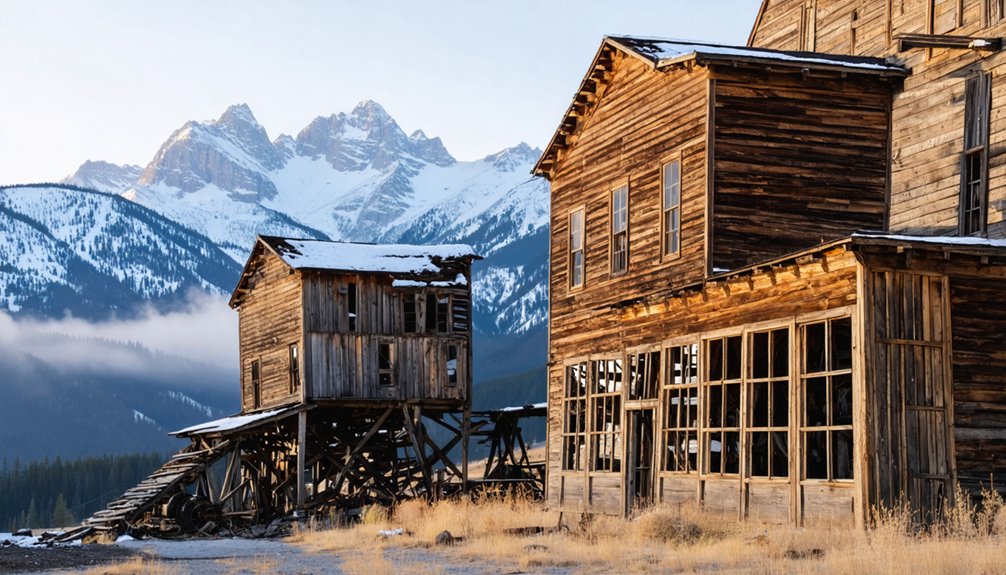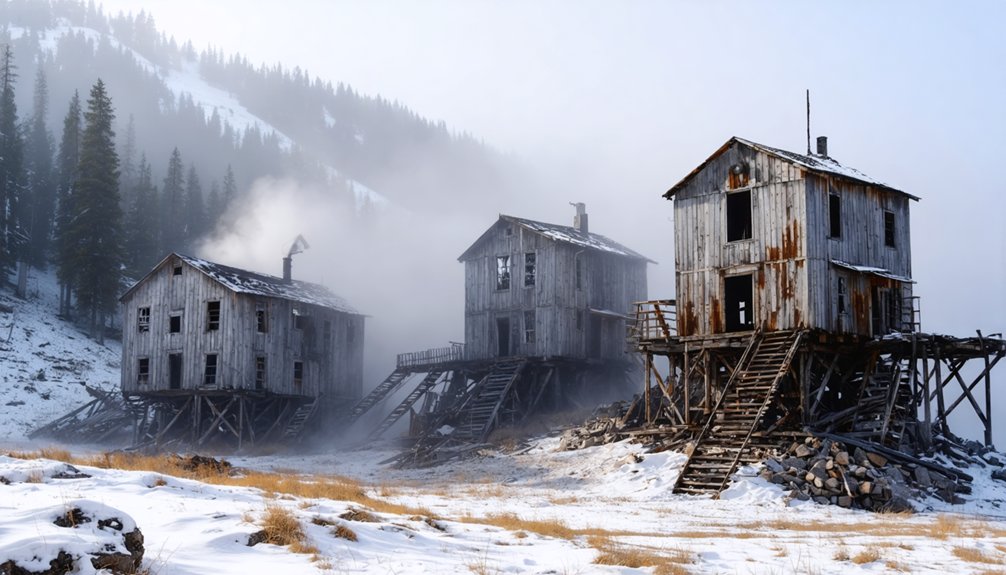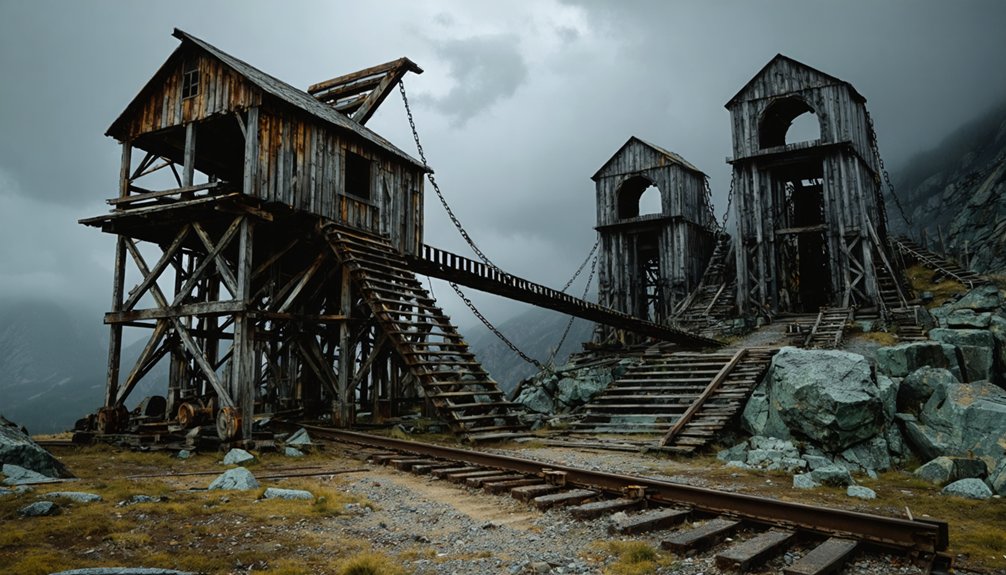You’ll find Colorado’s haunting mining ghost towns scattered across the Rocky Mountains, remnants of the 1858 Gold Rush that once buzzed with life. These abandoned settlements like Teller City with its 27 vacant saloons and Gilman’s toxic Superfund landscape tell stories of economic booms and devastating busts. The vibrant red-orange mountains of Ironton and preserved Victorian structures at Vicksburg reveal a complex past waiting to share its secrets.
Key Takeaways
- Teller City offers eerie exploration of 300+ abandoned structures after its 1884 silver market collapse left the booming town completely deserted by 1902.
- Gilman’s toxic legacy as a Superfund site features abandoned buildings with hazardous contamination, creating a forbidden ghost town atmosphere.
- Ironton’s distinctive red-orange mountains and 300 abandoned structures showcase dramatic environmental transformation from extensive mining activities.
- Vicksburg combines eerie abandonment with historical preservation, featuring original buildings now functioning as museums on the National Register.
- Colorado’s 1893 Silver Crash created numerous ghost towns when 435 mines closed, unemployment reached 25%, and communities rapidly emptied.
The Gold Rush Origins of Colorado’s Abandoned Mining Towns

When gold was discovered along the South Platte River and Cherry Creek in 1858, it sparked the Colorado Gold Rush that would permanently reshape the territory’s landscape.
The glint of gold in Colorado’s waters forever altered what was once merely wilderness.
You’re exploring the remnants of America’s second-largest gold rush, which peaked in 1859 when over 100,000 “Fifty-Niners” flocked to the Rockies seeking fortune.
These prospectors established the first mining towns like Montana City (later Denver), despite initially modest yields.
As the rush intensified, settlements sprung up wherever precious metals were found—Idaho Springs, Central City, Fairplay, Breckenridge, and Leadville each marking significant discoveries.
The influx of miners and accompanying economic activity propelled Colorado to territorial status by 1861 and eventual statehood in 1876, leaving behind a legacy of boom-and-bust mining towns. George A. Jackson’s discovery of gold in Clear Creek was a pivotal moment that further fueled the expansion of mining operations throughout the territory.
The discovery of silver in Summit County in 1864 expanded Colorado’s mining industry beyond gold, though miners delayed extensive silver mining until proper smelting facilities were constructed.
Teller City: The Forgotten Silver Empire in North Park
Tucked away in the dense forests of North Park, Teller City emerged as one of Colorado’s most dramatic boom-and-bust mining communities following a significant silver strike in 1879. Named for Senator Henry Teller, this silver boom town rapidly grew to over 1,500 residents with impressive infrastructure including 27 saloons, two newspapers, and the 40-room Yates House Hotel.
You’d find a complete but isolated community where freight arrived by stage from Laramie and two steam sawmills supported constant construction. The mine’s dubious reputation included the infamous One Hundred Foot Swindle that exemplified the deceptive mining practices of the era. Access to the ghost town requires traveling the last 3 miles on high-clearance 4WD roads that climb over a narrow mountain pass.
By 1884, however, plummeting silver prices devastated the economy. The population dwindled to just 300 by 1887, and by 1902, Teller City stood completely abandoned.
Today, you’ll discover only scattered foundations and cabin remnants along a three-quarter-mile trail through what nature has reclaimed.
The Tragic Labor History of Gilman’s Company Town

You’ll discover Gilman’s complex labor dynamics involved complete company dominance over workers’ professional and personal lives, with the New Jersey Zinc Company controlling housing, stores, and social spaces alongside employment from 1912 until operations ceased.
The Eagle Mine’s closure in 1984 followed EPA intervention after environmental catastrophe, with toxic contamination forcing immediate evacuation of all residents.
The abandoned company town, which once supported 300-400 workers and their families through zinc production, now stands as a deteriorating Superfund site, inaccessible to the public due to the extensive environmental damage from over a century of mining. The 1959 strike over pay rates and management rights showcased rare resistance against the company’s total control. The site’s designation as a Superfund site in 1986 marked the beginning of cleanup efforts that would continue until 2000.
Union Standoffs Impact
Despite its decades-long reputation as a model of labor stability, Gilman’s mining community experienced a dramatic shift in the 1950s when unionization efforts disrupted the town’s carefully cultivated social harmony.
You can trace this transformation to the Union of Mine, Mill, and Smelter Workers’ organizing campaign, which promised better wages and health insurance.
The union impact became most visible during the brief but contentious August 1954 strike, when workers demanded a ten-cent hourly raise and separate health facilities. Labor tensions manifested in physical altercations among miners, while mill workers largely resisted union involvement.
Though resolved with a five-cent compromise, the strike’s aftermath left lasting divisions.
This conflict marked Gilman’s departure from decades of exceptional labor peace, foreshadowing the eventual decline of this once-model company town. The economic downturn continued as mining operations gradually dwindled throughout the following decades. The community’s struggles continued until the New Jersey Zinc Company ceased operations, ultimately leading to Gilman becoming a Superfund site in 1986.
Eagle Mine Abandonment
When New Jersey Zinc Company shuttered the Eagle Mine in 1984 after nearly a century of operation, they orchestrated one of Colorado’s most controversial industrial abandonments.
As the mine flooded, workers watched their livelihoods vanish alongside Gilman Town’s very existence.
You’ll find it shocking that this wasn’t simply an economic decision—zinc reserves were nearly exhausted, and automotive industry changes had decreased demand.
Eagle Mine, once producing 85% of Colorado’s copper during the Depression and generating $12 million in 1951 alone, left behind more than memories.
The company town’s desertion in 1985-86 created an environmental catastrophe, with arsenic, cadmium, lead and zinc contaminating local soils and waterways.
The aftermath was so severe that in 1986, the EPA designated the 235-acre area as a Superfund site requiring extensive cleanup efforts.
Specimens of pyrite, rhodochrosite, sphalerite, and dolomite crystals from the Eagle Mine are now preserved in collections at geology museums, documenting the site’s mineral wealth.
What remains today is a ghostly reminder of corporate power‘s ultimate abandonment of the workers who built their fortune.
Ironton: Where Oxidized Mountainsides Tell a Mineral Tale
Approaching Ironton, you’ll notice the vibrant red-orange mountains whose oxidized minerals leached into creeks, creating the distinctive landscape that drew miners to this second-largest silver district in Colorado.
During the 1883 boom, workers constructed an astonishing 300 structures within just three weeks, transforming the 9,800-foot elevation site from Copper Glen into a thriving settlement.
The town’s strategic position as a transportation junction was cemented when two daily trains began servicing the area from Silverton, moving precious ore and essential supplies between the mining operations that briefly supported over 1,000 residents.
Red Iron-Stained Landscape
Among the most striking geological features of Colorado’s mining landscape, Ironton’s oxidized mountainsides create an otherworldly tableau of crimson and rust that hints at the area’s rich mineralization.
This distinctive red coloration results from extensive iron oxidation—hematite and limonite compounds formed when hydrothermal fluids altered the original rock composition.
As you explore this otherworldly terrain, you’ll witness how mining activities accelerated this natural process.
The extraction of sulfide-rich ores exposed fresh minerals to air and water, intensifying the red mineralization throughout the valleys.
Acidic drainage from abandoned mines continues to leach heavy metals, staining creek banks and mountainsides while corroding historic wooden structures.
These vivid iron-stained slopes stand as nature’s permanent record of mining impacts, simultaneously beautiful and emblematic of environmental transformation.
300 Buildings Overnight
The ghostly remains of Ironton extend beyond its rust-colored mountainsides to a settlement that materialized with astonishing speed at the height of Colorado’s mining frenzy.
When you visit this high-altitude ghost town, you’ll walk among structures that appeared virtually overnight in 1883—over 100 buildings erected within weeks.
These overnight constructions defined early mining settlements through their rapid assembly and practical design:
- Commercial infrastructure – 12 saloons and 4 restaurants emerged immediately
- Supply networks – Branch stores stocked by merchants from Silverton and Ouray
- Industrial facilities – Smelters and hoist houses for processing extracted minerals
- Community foundations – Schools and churches appeared by 1890
Despite the hasty construction, several buildings endure at 9,800 feet elevation, including the distinctive “White House” and Colorado Boy Hoist House.
Railroad’s Vital Connection
When Otto Mears completed the Silverton Railroad connection to Ironton in 1889, he transformed the mining district’s economic viability overnight.
This narrow-gauge engineering marvel crossed the challenging 11,018-foot Red Mountain Pass, establishing essential railroad history in Colorado’s mineral belt.
You’ll find that this transportation innovation slashed shipping costs dramatically.
Two daily trains delivered supplies and hauled away extracted ore with unprecedented efficiency, though winter’s heavy snowfall forced annual operational pauses from January through May.
Mining transportation evolved from slow pack trains to reliable rail service, making Ironton the district’s shipping hub.
Despite this infrastructure achievement, the 1893 silver demonetization devastated the region’s economy.
Vicksburg: the Ghost Town Born From Lost Burros
Lost burros inadvertently led to the founding of Vicksburg, one of Colorado’s most intriguing mining settlements, in 1867. Following burro trails, prospectors discovered gold in Clear Creek Canyon, establishing a mining camp that quickly expanded into a town named after shopkeeper Vick Keller.
At its peak around 1890, this mining heritage site boasted 600-700 residents before declining after the 1893 silver crash.
When you visit today, you’ll find:
- Original “Balm of Gilead” trees lining the main street, brought by burros and still thriving
- Elaborate water ditch systems that once served the community
- Several preserved buildings now functioning as museums
- Mining equipment remnants scattered throughout the site
Now listed on the National Register of Historic Places, Vicksburg remains one of Colorado’s best-preserved ghost towns, accessible via Forest Service Route 390.
Architectural Remains: What Victorian Ruins Reveal About Mining Life

While Vicksburg’s preserved buildings offer glimpses of a living ghost town, architectural ruins throughout Colorado’s mining landscapes tell deeper stories about Victorian-era mining communities.
As you explore these sites, you’ll notice distinctive patterns—residential clusters positioned uphill from processing areas, with centralized communal facilities forming social hubs. The architectural insights reveal class hierarchies: lavish multi-story boarding houses like Camp Bird near Telluride contrast with simple bunkhouses for laborers.
Mining infrastructure provides evidence of industrial ingenuity through surviving stone foundations, ore houses, and remnants of specialized equipment like Pelton wheels and smelter furnace bases.
Heavy timber framing with vertical siding dominates the wooden structures, reflecting the economic pragmatism of boom-period construction. Even in decay, these ruins document the industrial-commercial-residential organization that defined these once-thriving communities—physical proofs of Colorado’s mining heritage.
San Juan Mountains: High-Altitude Abandonment and Survival
Perched at elevations between 11,000 and 14,000 feet, Colorado’s San Juan Mountains host some of the most extreme mining settlements ever established in North America.
You’ll find environmental challenges that tested human endurance in these alpine settings, where miners battled nature’s fury while extracting wealth from the earth.
High altitude survival required adapting to:
Surviving the San Juan peaks demanded extraordinary adaptation to nature’s most unforgiving conditions.
- Severe winters with deadly snowfall and prolonged cold
- Treacherous transportation routes like the perilous Million Dollar Highway
- Isolation that necessitated self-sufficiency and animal labor
- Complex terrain demanding specialized mapping for navigation
Communities like Ouray and Silverton flourished despite these obstacles, growing from mere prospecting camps to substantial settlements.
The convergence of rugged individualism and harsh geography created a distinctive lifestyle where freedom came with significant risk—every day spent above 11,000 feet represented a triumph over nature’s most formidable barriers.
The 1893 Silver Crash: How Economic Forces Created Ghost Towns

The devastating 1893 Silver Crash transformed Colorado’s mining landscape from prosperous communities to abandoned ghost towns almost overnight.
When President Cleveland repealed the Sherman Silver Purchase Act, silver prices plummeted from 83 to 62 cents per ounce, making mining operations unprofitable.
You can trace the crash’s impact through staggering statistics: 377 businesses failed, 435 mines closed, and 45,000 workers lost their livelihoods.
These economic downturns led to 25% unemployment across Colorado, forcing families to abandon their homes in search of work elsewhere.
Mining towns emptied as businesses, schools, and services shut down.
The crisis sparked significant labor struggles, with increased unionization amid desperate conditions.
What remains today are haunting remnants of once-thriving communities—silent reflections of how quickly prosperity can vanish.
Preservation Efforts: Saving Colorado’s Mining Heritage
After the devastating silver crash emptied Colorado’s mining towns, preservationists began the enormous task of safeguarding this irreplaceable industrial heritage.
Despite preservation challenges like 23,000 hazardous mining features and 1,300 miles of impacted streams, organizations have made remarkable progress through strategic partnerships and funding.
Amid overwhelming obstacles, dedicated collaboration transforms Colorado’s dangerous mining past into protected historical treasures.
Key preservation approaches include:
- Multi-organizational collaboration between entities like Park County Office of Historic Preservation and the Ghost Town Club
- Substantial financial investment, including $300,000 for Paris Mill and $200,000 for Silver Plume
- Volunteer-driven restoration work at sites like Santiago Mill
- Implementation of three-category management systems for sustainable maintenance
You’ll find community involvement essential to these efforts, with volunteer work days during warmer months providing opportunities to participate in protecting Colorado’s mining legacy while respecting historic significance.
Frequently Asked Questions
Are Colorado’s Ghost Towns Legally Accessible for Exploration?
Most ghost towns require exploration permits as they’re privately owned. You’ll need permission to legally access them under Colorado’s ghost town regulations, despite their historical significance.
Can You Still Find Gold or Silver in Abandoned Mines?
Yes, you can find gold in abandoned mines. Waste piles contain higher concentrations than many active mines today. Before gold prospecting, verify mineral rights ownership, as these often remain privately controlled despite abandonment.
What Paranormal Activities Have Been Reported in These Ghost Towns?
You’ll encounter ghost sightings of miners and hotel residents, unexplained noises from mining accidents, sudden cold spots, objects moving independently, and apparitions appearing in photographs throughout these historically tragic locations.
How Dangerous Are Collapsing Structures in These Abandoned Mining Towns?
Like skeletal giants waiting to claim victims, collapsing structures pose extreme dangers. You’ll face lethal risks from compromised structural integrity without proper safety precautions, as evidenced by documented fatalities from sudden collapses.
Which Ghost Towns Offer Guided Tours Versus Self-Guided Experiences?
Ouray’s Ghost Towns offer professional guided tours, while Teller City, Independence, St. Elmo, and Animas Forks provide self-guided experiences with interpretive signage allowing you to explore at your own pace.
References
- https://www.colorado.com/articles/colorado-ghost-towns
- https://westernmininghistory.com/state/colorado/
- https://www.coloradolifemagazine.com/printpage/post/index/id/172
- https://www.worldatlas.com/cities/7-old-timey-mining-towns-in-colorado.html
- https://www.uchealth.org/today/ghost-towns-abound-in-colorado/
- https://www.uncovercolorado.com/ghost-towns/
- https://leadville.com/the-ghost-towns-of-leadville-and-beyond/
- https://en.wikipedia.org/wiki/List_of_ghost_towns_in_Colorado
- https://www.americansky.co.uk/colorado-holidays/explore-colorados-most-fascinating-gold-rush-towns
- https://argomilltour.com/colorado-gold-rush-history/



